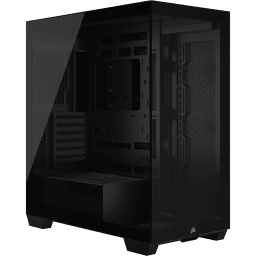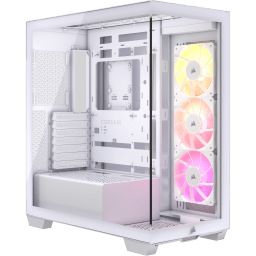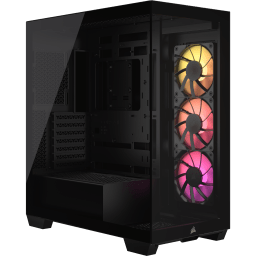With the announcement of the CORSAIR 3500X Series of cases, users now have three cases to consider when looking for an uninterrupted panoramic view into their PC. All three are great options, but there are many differences to be aware of to make sure you pick the correct option.
So, by the end of this page you’ll understand all the similarities and differences between the three. We’ll start with a quick matrix for those who know what they’re looking for, then we’ll get more detailed afterwards.
Note that the following matrix compares the 2500X, 6500X, and 3500X. The X variants of the 2500 and 6500 have glass front panels. There are airflow variants of the 2500 and 6500, but the glass front panel versions are the most relevant when we're talking about fishbowl cases.
| 2500X | 6500X | 3500X | |
| Dimensions (Width, Length, Height) | 304mm x 479mm x 376mm | 328mm x 481mm x 496mm | 240mm x 506mm x 460mm |
| Storage | 2x 2.5" SSDs, 2x 3.5" HDDs | 2x 2.5" SSDs, 2x 3.5" HDDs | 2x 2.5" SSDs, 2x 3.5" HDDs |
| Motherboard Compatibility | Mini-ITX, Micro-ATX | Mini-ITX, Micro-ATX, ATX, E-ATX (305mm x 277mm) |
Mini-ITX, Micro-ATX, ATX, E-ATX (305mm x 277mm)
|
| Available Colors | Black, White | Black, White | Black, White |
| Max GPU length | 400mm | 410mm | 410mm |
| Max CPU cooler height | 180mm | 190mm | 170mm |
| Max PSU length | 225mm | 225mm | 180mm |
| Fan Mounts (Top) | 3x 120mm; 2x 140mm | 3x 120mm; 3x 140mm |
3x 120mm, 2x 140mm
|
| Fan Mounts (Side) | 2x 120mm | 3x 120mm |
3 x 120mm, 2x 140mm
|
| Fan Mounts (Rear) | 1x 120mm | 1x 120mm; 1x 140mm |
1x 120mm
|
| Fan Mounts (Bottom) | 3x 120mm; 2x 140mm | 3x 120mm; 3x 140mm |
3x 120mm, 2x 140mm
|
| Radiator Compatibility (Top) | 360mm, 280mm, 240mm | 360mm, 280mm, 240mm |
360mm, 280mm, 240mm
|
| Radiator Compatibility (Side) | 240mm | 360mm, 240mm |
360mm, 280mm, 240mm
|
| Radiator Compatibility (Rear) | 120mm | 120mm, 140mm |
120mm
|
| Radiator Compatibility (Bottom) | 360mm, 280mm, 240mm | 360mm, 280mm, 240mm |
120mm
|
Dual chamber or standard?
Firstly, let’s talk about the biggest difference that sets the 3500X apart from the 2500 and 3500 Series cases. The 2500 and 6500 are dual-chamber cases, but what does that actually mean?
Dual-Chamber cases are split, unsurprisingly, into two sections. The biggest change here compared to regular cases is that the PSU is housed behind the motherboard tray. This creates a cleaner aesthetic in the front. Additionally, because this second chamber must be wide enough to fit a power supply, there is far more room for cable management.

3500X - Note the traditional layout and the visible power supply shroud

2500X

6500X
The downside is that it makes dual-chamber cases significantly wider than traditional cases where the power supply lives under the motherboard. For example, the 6500 Series is 118mm (4.6 inches) wider than the 3500X. This means that those with limited space but still want a fishbowl style case might be better off with a non-dual-chamber case, such as the 3500X.
Small form factor or mid-tower?



Another important consideration when choosing between these cases is the intended size of your build. The 2500 is our only small form factor fishbowl PC case at the time of writing. So if you’re after a small build and absolutely need the panoramic look, this is your only option.
If, however, you’re unconcerned about going with a small PC, then the 3500X and 6500 Series are both up to the task.
Airflow options
This is also a key difference. The 2500 and 6500 Series cases are available with AIRFLOW variants. This means that the front glass panel is replaced with a breathable mesh. This will result in lower temperatures, but does slightly undermine the whole fishbowl aesthetic.


The 3500X, by comparison, does not have an option for a front mesh panel. There are still enough intake and exhaust opportunities, but those who really want to keep their PC as cool as possible might prefer the 2500 or 6500 Series.
It’s worth mentioning here that all three cases in this article are fully capable of being custom watercooled, in addition to being compatible with a broad range of AIOs. Basically, when it comes to cooling in any of these cases, there are a lot of options.
Aesthetic differences
This part is more difficult to definitively describe, but we’re going to try anyway, in addition to copious imagery to help you make your decision. However, there is one part that you should be very aware of.
Now, we mentioned earlier that the 2500 and 6500 series, being dual chamber cases, house the PSU behind the motherboard tray. The 3500X does not, meaning that the power supply shroud is fully visible through the glass side panel. In term of performance, this makes no difference, but it is a very notable difference in terms of aesthetics.
Additionally, the 2500 and 6500 series, can also be upgraded with our Elite PC Case Panel kits. These replace the outer panels of the standard case and are available in five different colorways. The 3500X has no such options available, however, it is far more affordable than both the 2500 and 6500.
If you’re curious for more information about these cases, each one has its own dedicated article linked below.
PRODUCTS IN ARTICLE









